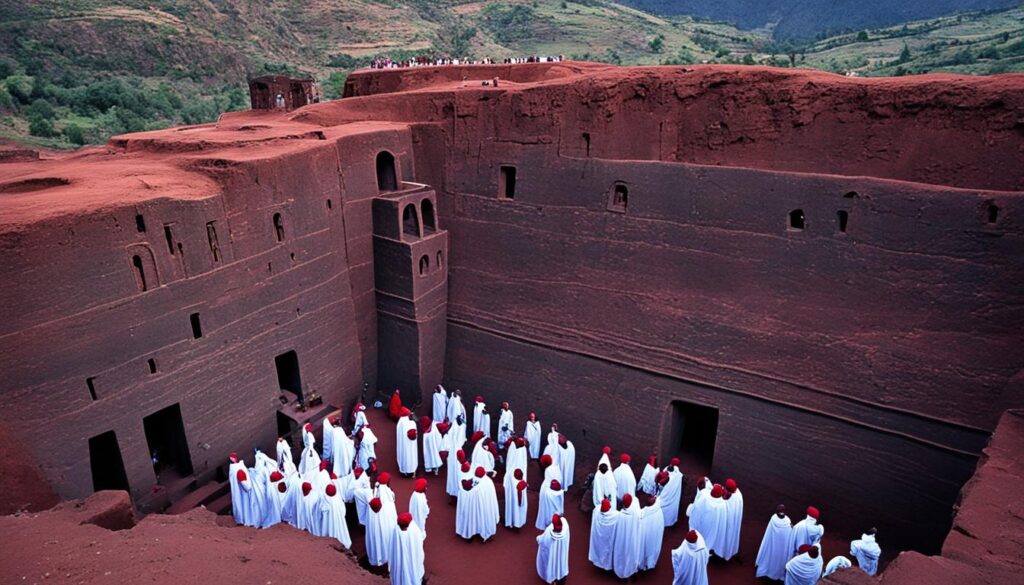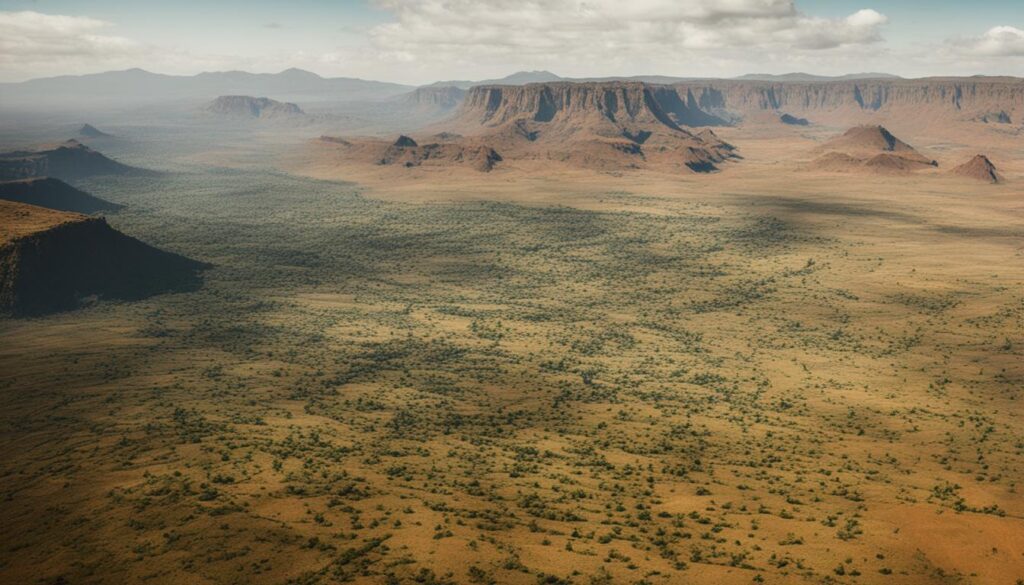Is Ethiopia East Africa?
When it comes to the geography of Africa, there’s an unexpected fact that might surprise you. Ethiopia, a country known for its rich history and cultural heritage, is actually located in East Africa. This East African nation holds a significant position in the region, with its unique landscapes, diverse wildlife, and ancient traditions.
Ethiopia is situated in the Horn of Africa and shares borders with several countries, including Eritrea, Djibouti, Somalia, Kenya, South Sudan, and Sudan. It is considered the easternmost projection of the African continent. The term “East Africa” refers to the eastern subregion of the African continent, encompassing countries like Tanzania, Kenya, Uganda, Rwanda, Burundi, and South Sudan.
Key Takeaways
- Ethiopia is part of East Africa, located in the Horn of Africa.
- It shares borders with Eritrea, Djibouti, Somalia, Kenya, South Sudan, and Sudan.
- The country is known for its diverse landscapes, rich history, and vibrant cultural heritage.
- Explore Ethiopia’s stunning mountain ranges, the Great Rift Valley, and unique attractions like the rock-hewn churches of Lalibela.
- Discover the beauty and wonders of Ethiopia, a captivating destination in East Africa.
Geography and Landscapes of Ethiopia
Ethiopia is known for its diverse and stunning landscapes. It is characterized by its vast highlands, stunning mountain ranges, fertile valleys, and expansive plateaus.
The country is home to several notable geographical features, including the Ethiopian Highlands, which are the largest continuous mountain ranges in Africa and include peaks such as Mount Ras Dashen and Mount Abuna Yosef.
Ethiopia also encompasses the Great Rift Valley, a geographical trench that runs through East Africa and is marked by numerous lakes, including Lake Tana and Lake Langano.
Additionally, the country is home to the Simien Mountains National Park, a UNESCO World Heritage site known for its dramatic cliffs, deep valleys, and unique wildlife.
These diverse landscapes make Ethiopia a popular destination for tourists, with attractions such as the rock-hewn churches of Lalibela, the Danakil Depression, and the historical city of Gondar.
Ethiopia’s Geographical Features
| Geographical Feature | Description |
|---|---|
| Ethiopian Highlands | The largest continuous mountain ranges in Africa, with peaks including Mount Ras Dashen and Mount Abuna Yosef. |
| Great Rift Valley | A geographical trench that runs through East Africa and is characterized by numerous lakes, including Lake Tana and Lake Langano. |
| Simien Mountains National Park | A UNESCO World Heritage site known for its dramatic cliffs, deep valleys, and unique wildlife. |
Image:
History and Cultural Heritage of Ethiopia

Ethiopia has a fascinating history that spans over 3,000 years, making it one of the oldest independent countries in the world. The country has been home to ancient civilizations, leaving behind a rich tapestry of historical and cultural heritage. One notable civilization is the Kingdom of Aksum, which flourished as a major trading power in the ancient world.
An important aspect of Ethiopian culture is its ancient Christian traditions, deeply rooted in the Ethiopian Orthodox Church. These traditions have shaped the religious and cultural landscape of the country, leaving a lasting impact on its people’s way of life. One remarkable manifestation of this heritage is the rock-hewn churches of Lalibela, a UNESCO World Heritage site. These remarkable churches, carved out of solid rock, stand as a testament to Ethiopia’s rich religious and architectural history.
Ethiopia is also known for its vibrant music, dance, and art, which reflect the diversity of its people and their cultural traditions. Traditional Ethiopian music, with its distinctive rhythms and melodies, evokes a sense of deep pride and cultural identity. Dance plays a significant role in Ethiopian celebrations, showcasing intricate footwork, colorful costumes, and spirited performances.
The artistic expression in Ethiopia extends beyond music and dance to other forms of art, such as painting and sculpture. The country’s artists draw inspiration from their surroundings, capturing the beauty of Ethiopia’s landscapes, cultural traditions, and historical events.
Overall, Ethiopia’s history and cultural heritage are intertwined, shaping the country’s identity and leaving a lasting impression on its people and visitors alike. Exploring the ancient sites, immersing in the vibrant traditions, and appreciating the artistic expressions are all ways to experience and appreciate Ethiopia’s rich history and cultural heritage.
Ethiopia’s Neighboring Countries in East Africa

Ethiopia is surrounded by several countries in the East African region. Its strategic location in the Horn of Africa positions it as a gateway to the diverse landscapes and vibrant cultures of the continent. Let’s explore the countries that border Ethiopia and discover the unique experiences they offer.
1. Eritrea
To the north, Ethiopia shares a border with Eritrea. Once part of Ethiopia before gaining its independence in 1993, Eritrea boasts a rich history and a stunning coastline along the Red Sea. It offers opportunities for cultural exploration and beautiful coastal landscapes.
2. Djibouti
Nestled on the northeastern edge of Ethiopia, Djibouti is a small country known for its strategic location on the Red Sea and the Gulf of Aden. It serves as a key trade route and provides access to the stunning beaches and diverse marine life of the region.
3. Somalia
To the east and southeast, Ethiopia shares borders with Somalia. Somalia is a country with a rich cultural heritage and a diverse population. It offers visitors an opportunity to experience Somali traditions, explore ancient ruins, and witness the stunning landscapes along the Indian Ocean coastline.
4. Kenya
To the south, Ethiopia shares a border with Kenya, a prominent country in East Africa known for its wildlife and natural beauty. Kenya is home to world-famous national parks such as Maasai Mara, Amboseli, and Tsavo, offering incredible opportunities for safari adventures and encounters with iconic African wildlife.
5. South Sudan
To the west, Ethiopia shares a border with South Sudan, a relatively new country that gained independence in 2011. South Sudan is a landlocked nation with diverse ethnic groups and a wealth of natural resources. Visitors can explore its vibrant culture and experience the untamed wilderness of its national parks and wildlife reserves.
6. Sudan
Lastly, to the northwest, Ethiopia shares a border with Sudan. Sudan is a country with a rich history and cultural heritage. It offers visitors the chance to explore ancient archaeological sites such as the Royal City of Meroe and immerse themselves in the vibrant cultures of its diverse ethnic groups.
These neighboring countries showcase the diversity and beauty of the East African region. By venturing beyond Ethiopia’s borders, travelers can gain a deeper understanding and appreciation of the rich cultural tapestry and natural wonders that East Africa has to offer.
Conclusion
In conclusion, Ethiopia is an integral part of East Africa and is located in the Horn of Africa. It shares borders with several neighboring countries, including Eritrea, Djibouti, Somalia, Kenya, South Sudan, and Sudan. These geographical connections contribute to the country’s rich cultural diversity and historical significance.
Ethiopia’s diverse landscapes, such as the Ethiopian Highlands, the Great Rift Valley, and the Simien Mountains, make it a fascinating destination for travelers seeking natural beauty and adventure. Moreover, the country’s historical and cultural heritage, with iconic sites like the rock-hewn churches of Lalibela and the ancient Kingdom of Aksum, offer glimpses into its millennia-old history.
Visiting Ethiopia is an opportunity to immerse oneself in the unique traditions, customs, and vibrant cultural expressions of its people. Whether exploring breathtaking landscapes, discovering ancient archaeological marvels, or engaging with the warm-hearted local communities, Ethiopia offers an unforgettable experience at every turn.
Embark on a journey of exploration and discovery to the heart of East Africa, where Ethiopia sparks curiosity and captivates with its natural beauty, historical marvels, and cultural treasures. Join us in uncovering the wonders that await in this remarkable country.






